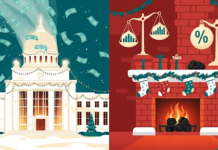September is here, and with it, investors’ concerns about whether the Federal Reserve has been slow to react to shifting economic conditions. The stock market stumbled this week, adding to a sense of uncertainty as the Fed prepares for its long-anticipated interest rate cut. But has the central bank waited too long? As we dive into this week’s issue of The Market Pulse, we explore how investors are grappling with recession fears and why tech stocks, in particular, have taken such a hit.
This week’s edition isn’t just about the market’s pain points – it’s about making sense of the bigger picture. We’ll break down what’s behind the S&P 500’s slump, why September has a notorious reputation for volatility, and how investors should interpret the Fed’s next move. In our “This Week I Learned” section, we’ll dive into how the market’s current turbulence might be offering a reset for valuations. And in “The Fun Corner”, we’ll lighten things up with a quirky take on stock market patterns that might surprise you.
Ready to be smarter this week? Let’s get started.
This Week I Learned…
What a September Slump Really Means
It’s no secret that September is often a rough month for stocks, but this week I learned that this isn’t just a fluke – it’s backed by almost a century of data! Since 1928, the S&P 500 has posted an average monthly decline of 1.2% in September, and it’s only ended the month higher 44.3% of the time. For investors, understanding this pattern can provide a sense of historical context, especially in a year when Fed policy, economic data, and global uncertainties are creating a perfect storm of worry.
But here’s something interesting: while big tech stocks like Nvidia may have tanked this week, pulling down the Nasdaq, some strategists believe this could be an opportunity to reset overinflated valuations. Companies trading at sky-high price-to-earnings ratios may see their numbers fall to more sustainable levels, while undervalued sectors could rise in response. If earnings growth improves alongside more reasonable valuations, this “September slump” might just create a healthier market in the long run.
So, this week I learned that even in times of market chaos, there’s often a silver lining for patient investors who know how to navigate these tricky waters.
The Fun Corner
When the Market Takes a Fall, Remember This
They say “markets have a mind of their own”, but maybe we should start thinking of them as that one friend who’s overly dramatic in September. Fun fact: historically, September has been the stock market’s worst month – a title it’s held since 1928. So, maybe instead of worrying about the sky falling every time the S&P takes a hit, we should think of September as the market’s “drama queen” phase.
Here’s a twist: there’s a pattern known as the “Presidential Cycle,” where the stock market tends to underperform in the second year of a new presidency – and we’re right in the middle of it! Coincidence, or does the market just love a bit of theatrics?
The next time your portfolio feels the September sting, just remember: history suggests it’s probably just a phase. Besides, there’s always October… what could go wrong, right?
Is the Fed Too Late? Markets Struggle Amid Recession Fears
The stock market is facing one of its toughest months, with investors increasingly worried that the Federal Reserve may have missed its window to prevent a recession. After raising rates aggressively from near zero in 2022 to over 5% by mid-2023, the Fed is finally set to deliver a long-awaited rate cut. But the timing has everyone on edge.
Recent data has been a mixed bag. Manufacturing is contracting, consumer spending is slowing, and key recession indicators, like the yield curve, are flashing warnings. Yet, the August jobs report did little to provide clarity. The Fed now faces a critical decision: will they opt for a moderate 25 basis point cut or go bigger with a 50-point reduction? Investors are left guessing, with 70% expecting a smaller move, but the risk of a deeper recession looms large.
Technology stocks, long the market’s darlings, have been hit hardest. Nvidia, a major player in the AI boom, saw its market value drop by $406 billion in a single week, the largest loss for any U.S. company ever. But amid these losses, there’s hope that the market could reset and stabilize.
As Fed watchers await next week’s inflation data, one thing is clear: a delicate balancing act is underway. If the Fed overshoots, it could risk pushing the economy into a recession. But if it manages a “soft landing,” we could see the economy avoid a deeper downturn. Investors should prepare for more volatility – and opportunities – ahead.
The Last Say
The Fog of Uncertainty
As we wrap up this week’s issue of The Market Pulse, it’s clear that uncertainty is the theme dominating market sentiment. The Federal Reserve’s potential rate cut is causing both hope and fear. Investors are left wondering: Is this too little, too late, or could it prevent a deeper downturn? Only time, and next week’s inflation data, will tell.
But it’s not all gloom. Even in a tough market, opportunities arise. The September slump could be a chance for overvalued stocks to correct and for undervalued sectors to shine. Investors who stay focused on the fundamentals, like earnings growth and valuation resets, may come out on top once the dust settles.
In a month known for market drama, patience and careful strategy are more important than ever. The road ahead might be rocky, but for those prepared, it could be one of opportunity as well.
Until next week, stay smart and stay on alert!

























